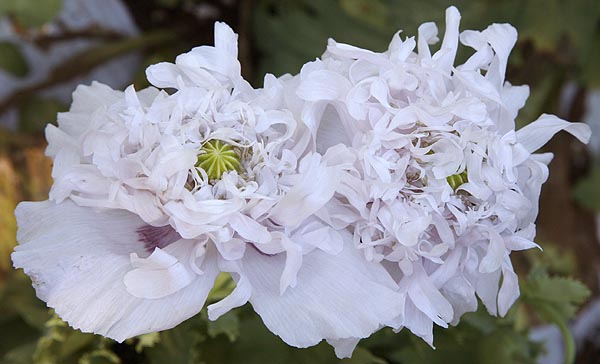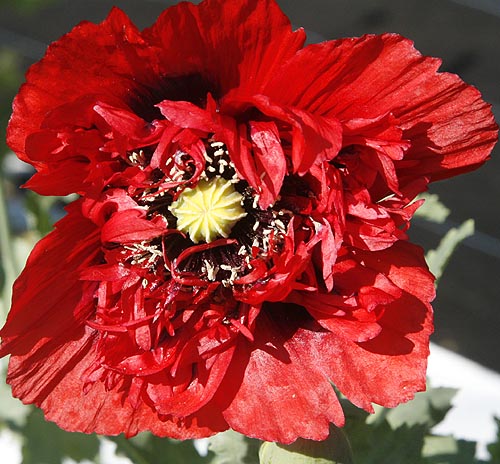Dwarf Double poppies are one of the most delightful plants to grow for early
flowers. This variety flowers prolifically over many weeks. The slightly blue
green foliage beautifully offsets the light pink or red double flowers that
look more like fluffy headdresses and would be perfect wedding flowers. Plants
like cooler weather and grow easily from direct seeding flowering in about 10
weeks from germination. Ideal for deck planters, borders and cooler sunny locations.
Needs full sun and some water but is very easy to grow with little maintenance.
Seeds can be used to decorate baked goods or other culinary creations.
This variety is a prolific bloomer but has fairly small pods and it would be
an extremely tedious and time consuming operation. Just grow the beautiful flowers,
enjoy them and maybe eat the seeds.
Description of Dwarf Double Poppy (Papaver somniferum).
There are many different varieties of poppy. This one is short with double flowers.
It has an upright nature and grows to about 2 feet (60 cm) in height. A fast
growing annual it first produces a mass of blue green leaves in a semi upright
rosette of lobate leaves that have a thick central stalk and crinkled indented
lobes with a strongly serrated edge. In late spring strong stiff stems emerge
with more sinuate or heart shaped leaves wrapped around the stem at intervals.
The stem ends in a large single flower bud which opens into a bowl shaped flower
with four or five large outer petals in either pale pink or red. These most
commonly have darker markings at the base of the petal. Inside these petals
are a mass of thin frilly petals massed around a central yellow green ovary
in the center. While blooms tend to be short lived the plant produces masses
of flowers and the plant will flower for 4-6 weeks. After the flower the petals
fall to reveal the large pod which is dark purple to purple brown in color but
may turn white in bright sunlight. These bulbous pods are very attractive and
can be used in floral decorations. The small seeds emerge from the top of the
pod and are easily removed.
Growing Dwarf Double Poppy (Papaver somniferum) from Seed.
Poppies do not like to be transplanted so direct sowing is recommended.
Poppies prefer cooler weather and will not grow as well in zone 9 or warmer.
They prefer it when temperatures get cooler and a overnight temperature drop
of around 20°F (6°C) is ideal.
Direct sowing.
Plant poppies as soon as the ground is workable. This will depend on your zone
but if its not frozen and there is no more snow or very cold temperatures predicted
then start you poppies. Clear the ground and sow the seeds very thinly. Cover
lightly we soil, this can be achieved by careful sprinkle or using a wide messed
kitchen sieve to sprinkle seeds (don't take one from the kitchen however). Keep
seeds moist until they germinate, which can take anywhere from 7 -25 days depending
on what the weather does. Once growing strongly thin plants to about 8"
(20 cm) apart. Keep watered throughout their cycle.
Sowing in planters.
Poppies make great pot plants for the deck or other areas of the garden. They
bloom earlier in the year than many plants so give color before most annuals
are ready to bloom. Follow directions for direct sowing.
Sowing indoors.
Poppies really don't transplant well because they form a large taproot. So if
you need to start your plants inside use tall (or long depending on how you
measure) peat or paper pots. You need something that will allow the plant to
develop its long root system that you can plant directly in the ground without
disturbing the roots.
Plant just a few seeds in each pot and cover them lightly with soil. See our
general growing instructions for more detailed description on planting seeds.
Keep at cool temperatures night-time temperatures of between 35-45°F (1.6-7.2°C)
and day-time temperatures of between 50-65°F (10-18°C) are close to
optimal any warmer and poppies may not germinate. Once seedlings appear they
can be thinned to the desired number per pot.
Harden plants before planting outside, ensure that plants are kept moist as
peat or paper pots tend to dry out very quickly. Take care not to disturb the
roots when transplanting, plants may flop over and look unhappy for several
days after transplant but most usually recover if the roots have been left alone.
Keep moist at all times until the plants are well established.
Location and Care of Dwarf Double Poppy (Papaver somniferum).
Poppies prefer full
sun in a well drained soil. A sandy or sandy loam soil is
ideal. They don't like heavy soils and really don't do well in clay. If you
have clay soil you will need to amend it with a good amount of well composted
organic material to ensure good drainage or grow your poppies in pots of imported
soil.
Dwarf Double poppies also like a good amount of organic material for them to grow strongly. Adding at least two inches to the soil and digging it in before planting is idea, more if you have clay soil that has not been previously amended. Poppies like cooler weather which is great for those in zones 6 and higher but zone 7 or lower may need to take extra care about location. Pick a spot that gets some shade around the noon hours to keep the plants cooler or grow on the north side of buildings, walls or trees, areas that stay cooler but still have good air flow.
Poppies begin to flower about 8-10 weeks after they germinate so if planted
early they give a really lovely early summer flowering when most other plants
are still thinking about flowering.
Plant 8-12" (20-30cm) apart to encourage good strong plants. An application
of high phosphate fertilizer when the flower buds are just beginning to form
will help promote profuse flowering. To promote more flowers cut the old blooms
off just as the petals are falling.
Harvesting of Dwarf Double Poppy (Papaver somniferum).
Seeds are easily harvested from the pods. Wait until the pods are dry and either
brown, white or purple then cut off the stems and immediately upend into a bucket
the seeds drop out of the pod into the bucket easily. Spread seeds to dry in
a warm sunny indoor location for a brief period then store in air tight jars
in a cooler dark place. Seeds for eating will keep of several years.
Culinary Uses of Dwarf Double Poppy (Papaver somniferum).
Everyone seems to like poppy seeds. They are used in all kinds of baked goods.
The seeds are highly nutritious containing about 22.7% protein, 48% fat, 9.8%
carbohydrate, 7.1% ash. They are also a good source of lecithin.
The seeds are perfectly safe to eat, containing very little if any of the narcotic
principles. However, although the seeds contain no narcotic alkaloids, analysis
of the urine following their ingestion may produce similar results to the analysis
of the urine of morphine or heroin addicts.
In some countries the leaves are also eaten when they are young, often at the
seedling stage. However caution is advised as it is not clear if the leaves
contain any narcotic compounds. The leaves are mildly rough and best consumed
cooked unless you like unusual textures.
Other uses of Dwarf Double Poppy (Papaver somniferum).
The blooms make stunning floral arrangements and keep well in the vase. The
pods are also beautiful for flower arrangements, they can also be dried for
winter arrangements and dried floral projects. Cut the pods off leaving a long
stem if possible and hang upside down to dry.










